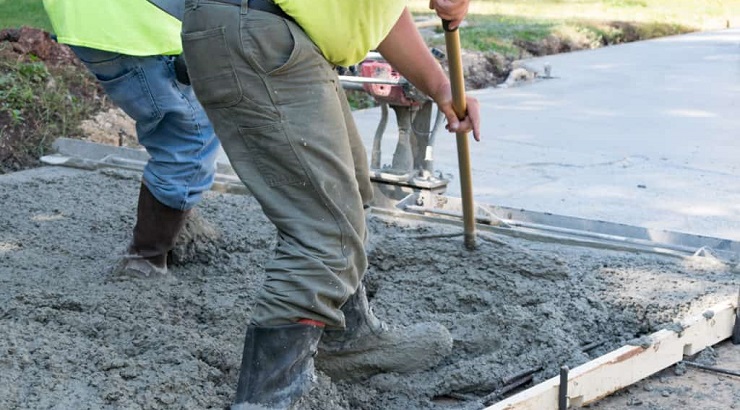Self Building
How to Finish Concrete Floor Like a Pro in 7 Steps
A guide to finishing a concrete slab, from spreading to troweling.

Finishing a concrete floor is not as difficult as it appears. With the right tools and attitude, even a beginner can undertake the project successfully with ease.
This article will help you learn how to finish concrete floor like a professional. Before we start on the steps, here is a list of concrete finish tools you will require.
Concrete finish tools
- Concrete screed – Used for the preliminary smoothing of freshly placed concrete.
- Concrete Darby – This is a long, flat tool with two handles on a flat plate with slightly lipped edges. It is used to smoothen a concrete slab.
- Concrete floats – Used for removing ridges, filling cavities and polishing the surface.
- Concrete groover – Used for jointing concrete to prevent cracks.
- Concrete finishing trowel – Used for final smoothing of the slab at the end of the finishing procedure.
- Concrete finishing broom – These are brooms with softer bristles compared with ordinary brooms. They are used to create a texture on the slab, either to decorate it or to create a non-slip floor.
Now let’s get started with our concrete smoothing task.
Step 1. Spread the concrete
As concrete is being poured, a team of workers should move in with square shovels or similar tools to push and pull the wet concrete into place, ensuring that the form is completely and evenly filled.
Additionally, immediately after pouring, make sure that the form appears to be full, and the surface is even. If needed, use a trowel or flat shovel to move wet mix from high spots and fill voids.
To prevent air pockets, gently tap the form on all sides with a hammer. This vibrates the wet concrete, aiding in its settling.
Step 2. Screed the concrete
This step involves the removal of excess concrete and leveling the surface of the concrete. It is done using a straight 2×4 lumber, which is often referred to as screed board.
Start by placing the screed board across the forms (blockades holding the concrete in place). Push or pull the 2×4 across the forms with a back-and-forth sawing motion.
Drive concrete into voids and low spots in front of the screed to fill the spaces. Repeat the procedure to completely remove the excess concrete.
Smoothing the concrete is not necessary at this stage; focus on achieving a uniformly flat surface by screeding three or four times, or more
Step 3. Float the surface
The process levels ridges, fills post-screeding spaces, and embeds uneven aggregate for smoother finishing.
It involves sweeping a concrete Darby in overlapping curves to compress the surface, reduce swellings, and fill spaces. Some water may float on the slab, which should be allowed to disappear before proceeding to the next stage.
Step 4. Edge the concrete
Once the water disappears, move an edging tool back and forth along the edge of the form. Elevate the main edge a little.
Make long strokes, while working the aggregate back, until you get smooth, rounded edges along the border of the slab using an edger.
Step 5. Create groove joints
This is a very important step in concrete finishing. It involves cutting grooves (control joints) into the concrete slab to prevent inevitable cracking.
Grooves work by directing cracks in such a way that the looks and functionality of the concrete slab are minimally compromised.
Using a grooving tool, create grooves 25% of the way through the depth of the concrete. The span between the grooves should not be more than 24 times the depth of the slab.
RELATED: Popular Types of Flooring Materials for Modern Homes
Grooves should be created on every inside corner of the concrete slab and every corner that touches a building or step. These areas are prone to developing cracks.
Once this is done, you should now proceed to float and trowel the surface to smooth and compact it.
Step 6. Trowel the surface
In the initial finishing stages, the surface is flat and uniform, but may have an inconsistent texture.
Depending on your preferences, brooming creates an even texture, while troweling at this point results in a smoother surface.
For a smoother finish, trowel immediately after adding expansion joints. Begin at a distant edge and work backward to avoid marring the finished work.
RELATED: Most Popular Types of Concrete Floor Finishes
Use broad, sweeping motions with moderate downward pressure, keeping the leading edge slightly raised.
Step 7. Protect the slab
After finishing, shield the concrete from foot traffic, debris, and rain for at least 24 hours. Use scrap lumber and tarps to protect it.
Avoid foot traffic for 3–4 days and vehicles for a week.
After 28 days, apply a concrete sealer for protection. Use a protective sealer after 30 days to prevent stains and extend the slab’s lifespan.
Safety precautions
To safeguard against chemical burns, always wear rubber gloves and safety glasses when working with wet concrete.
Additionally, use long pants, a long-sleeve shirt, and rubber boots, especially if you’ll be standing in the wet concrete.
In case of skin contact, promptly rinse the affected area with plain water.












